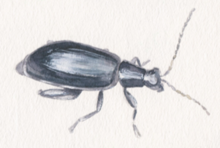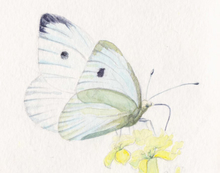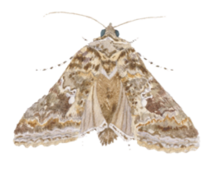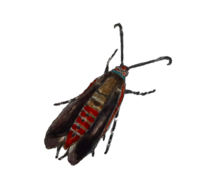For each vegetable crop, there are a series of insects that show up nearly every year. Growers should anticipate these insect pests and make a plan for management ahead of time.
We've created cropping calendars that provide an overview of the insects common to Minnesota vegetable crops, when growers should expect to see them, and management strategies.
See the Midwest Vegetable Production Guide for Commercial Growers for up-to-date pesticide recommendations.
Brassica insects
These insects are common in broccoli, cabbage, cauliflower, kale and other plants in the Brassica family. There are five insects that farmers and gardeners should anticipate in their Brassica crops every year.
Open the cropping calendar to download and print. The text in this illustration is repeated in the following elements on this page.
Cabbage maggot (Delia radicum)
- Cabbage maggots have 1-3 generations per year.
- They cause problems in May through early June, especially in wet years.
- The cabbage fly lays its eggs at the base of plants, and the larvae feed on roots.
- Cabbage maggots are most common in wet soils with residue; avoid planting in areas with fresh manure or a recently terminated cover crop.
Flea beetles (Phyllotreta cruciferae)
- Flea beetles have 1-3 generations per year.
- Flea beetles are most damaging in May and early June but can cause damage throughout the year.
- Adult flea beetles cause damage to plants by chewing holes in leaves.
- Flea beetles are most attracted to “spicy” Brassicas like arugula and mustard; these plants can be used as trap crops to lure beetles away from the primary crop.
- The threshold for spraying flea beetles is 10-20% leaf area loss. Spinosad as well as combinations of neem and pyrethrin can be effective for organic growers.
- Conventional growers should consult the Midwest Guide for Commercial Vegetable Crops for up-to-date pesticide recommendations.
Management
- For both cabbage maggot and flea beetle, consider transplanting large healthy plants instead of direct seeding; larger transplants will be better able to withstand damage.
- Waiting until late May or early June to plant may also allow you to miss the main egg-laying window.
- Growers can also use row covers immediately after planting to exclude cabbage maggots and flea beetles.
Diamondback moth (Plutella xylostella)
- Diamondback moths have 4-6 generations per year.
- They overwinter in Minnesota and show up in early summer.
- They lay eggs on the leaf veins of plants and larvae eat holes in the leaves.
- Diamondback moths are present throughout the summer.
Imported cabbage worm (Pieris rapae)
- Imported cabbage worms have 1-3 generations per year.
- They overwinter in Minnesota and emerge in midsummer.
- They lay eggs individually on the bottom sides of leaves, and larvae eat holes in the leaves.
- Imported cabbage worms are present throughout the summer.
Cabbage looper (Trichoplusia ni)
- Cabbage loopers have 3-5 generations per year.
- They do not overwinter in Minnesota but migrate north around midsummer.
- They lay eggs individually on the bottom sides of leaves, and larvae eat holes in the leaves.
- Cabbage loopers are present throughout the summer.
Management
For all three cabbage caterpillars, row covers can be effective. Scout early and often for egg masses and squish them. Strips of flowering perennials in your fields can attract beneficial insects, which may eat or parasitize the larvae of these insects.
- Spray thresholds until the plants begin to form heads:
- Diamondback moth: 50% of plants infected with at least 5 larvae per plant.
- Cabbage worm and cabbage looper: 20-30% of plants infested.
- Spray thresholds after head formation: 10% of plants infested with any caterpillar larvae.
- Bt and Spinosad products are effective for organic growers.
- Conventional growers should consult the Midwest Guide for Commercial Vegetable Crops for up-to-date pesticide recommendations.
Pumpkin and squash insects
Striped cucumber beetle, squash bug and squash vine borer are three insects that farmers and gardeners should anticipate in their squash and pumpkins every year.
Open the cropping calendar to download and print. The text in this illustration is repeated in the following elements on this page.
Striped cucumber beetle (Phyllotreta cruciferae)
- Striped cucumber beetles have one generation per year in Minnesota.
- They emerge immediately after planting in the spring.
- They lay eggs at the base of plants and larvae feed on the roots.
- Most damage is done by adults, which chew holes in leaves and can transmit a pathogen called bacterial wilt, which causes plants to wilt and die.
Management
- Growers should use bacterial wilt-resistant varieties when possible.
- Silver mulch can repel beetles, and thick straw or plastic mulch may help to prevent egg-laying.
- Transplanting instead of direct seeding will result in more tolerance to cucumber beetles.
- Growers can also use row covers until flowering, or kaolin clay every few weeks to deter beetles.
- Cucumber beetles are very attracted to blue hubbard squash; these plants can be used as trap crops.
- The spray threshold for cucumber beetles is one beetle per plant on cucumber, cantaloupe and watermelon (these plants are more prone to bacterial wilt), and five beetles per plant on pumpkin and squash.
Squash bug (Anasa tristis)
- Squash bugs have one generation per year in Minnesota.
- They emerge in early to mid-summer.
- Adults lay eggs in clumps on the underside of leaves.
- Nymphs (young bugs) and adults suck sap from leaves, which causes wilting and yellowish-brown spots.
- A single female can lay 250 eggs.
Management
- Squash bugs overwinter in debris from pumpkins and squash. Clean fields well and compost or till residues to prevent overwintering.
- Start scouting for egg clusters in early summer and squish them.
- Nymphs can be hit off of plants into buckets of soapy water.
- Certain varieties such as sweet cheese pumpkins and royal acorn squash are more tolerant to squash bugs.
- Pesticides are most effective on nymphs (young bugs), so only spray in early to midsummer.
- Spray if populations are high and plants are wilting, and make sure to spray underneath leaves.
Squash vine borer (Melittia cucurbitae)
- Squash vine borers have one generation per year.
- They emerge in early to mid-summer.
- Adult moths lay eggs at the base of plants, and the larvae tunnel through the plant stem.
- The larvae overwinter in the soil beneath plants, so rotating crops is very important.
Management
- Growers can trap moths using yellow buckets of soapy water.
- Several varieties of cucurbits are relatively tolerant to squash vine borer including cucumbers, melons, and squash or pumpkins in the Cucurbita moschata species.
- Summer squash is very susceptible; plant it in July to miss the active period.
- Use row covers to exclude squash vine borers until plants begin to flower.
- Once infected, cut into the base of the stem of infected plants to manually remove the larvae, or remove infected plants entirely.
- For growers interested in biocontrol products, Bt and Stienernema nematodes can provide some control.
- Insecticides should be applied when adults are active and flying and should be applied near the base of plants.
These insects can also cause damage to squash and pumpkins, but are not present or abundant every year:
Reviewed in 2021









